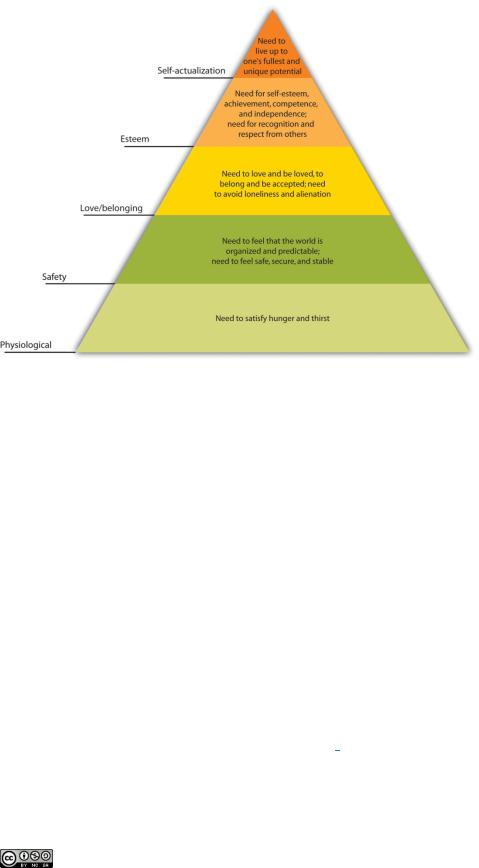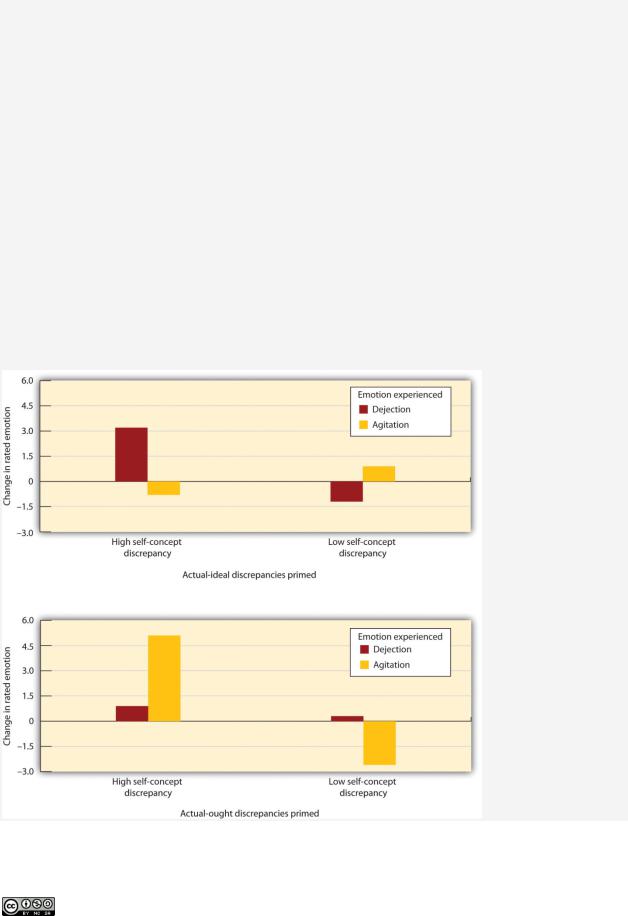
- •Preface
- •Approach and Pedagogy
- •Chapter 1
- •Introducing Psychology
- •1.1 Psychology as a Science
- •The Problem of Intuition
- •Research Focus: Unconscious Preferences for the Letters of Our Own Name
- •Why Psychologists Rely on Empirical Methods
- •Levels of Explanation in Psychology
- •The Challenges of Studying Psychology
- •1.2 The Evolution of Psychology: History, Approaches, and Questions
- •Early Psychologists
- •Structuralism: Introspection and the Awareness of Subjective Experience
- •Functionalism and Evolutionary Psychology
- •Psychodynamic Psychology
- •Behaviorism and the Question of Free Will
- •Research Focus: Do We Have Free Will?
- •The Cognitive Approach and Cognitive Neuroscience
- •The War of the Ghosts
- •Social-Cultural Psychology
- •The Many Disciplines of Psychology
- •Psychology in Everyday Life: How to Effectively Learn and Remember
- •1.3 Chapter Summary
- •Chapter 2
- •Psychological Science
- •Psychological Journals
- •2.1 Psychologists Use the Scientific Method to Guide Their Research
- •The Scientific Method
- •Laws and Theories as Organizing Principles
- •The Research Hypothesis
- •Conducting Ethical Research
- •Characteristics of an Ethical Research Project Using Human Participants
- •Ensuring That Research Is Ethical
- •Research With Animals
- •APA Guidelines on Humane Care and Use of Animals in Research
- •Descriptive Research: Assessing the Current State of Affairs
- •Correlational Research: Seeking Relationships Among Variables
- •Experimental Research: Understanding the Causes of Behavior
- •Research Focus: Video Games and Aggression
- •2.3 You Can Be an Informed Consumer of Psychological Research
- •Threats to the Validity of Research
- •Psychology in Everyday Life: Critically Evaluating the Validity of Websites
- •2.4 Chapter Summary
- •Chapter 3
- •Brains, Bodies, and Behavior
- •Did a Neurological Disorder Cause a Musician to Compose Boléro and an Artist to Paint It 66 Years Later?
- •3.1 The Neuron Is the Building Block of the Nervous System
- •Neurons Communicate Using Electricity and Chemicals
- •Video Clip: The Electrochemical Action of the Neuron
- •Neurotransmitters: The Body’s Chemical Messengers
- •3.2 Our Brains Control Our Thoughts, Feelings, and Behavior
- •The Old Brain: Wired for Survival
- •The Cerebral Cortex Creates Consciousness and Thinking
- •Functions of the Cortex
- •The Brain Is Flexible: Neuroplasticity
- •Research Focus: Identifying the Unique Functions of the Left and Right Hemispheres Using Split-Brain Patients
- •Psychology in Everyday Life: Why Are Some People Left-Handed?
- •3.3 Psychologists Study the Brain Using Many Different Methods
- •Lesions Provide a Picture of What Is Missing
- •Recording Electrical Activity in the Brain
- •Peeking Inside the Brain: Neuroimaging
- •Research Focus: Cyberostracism
- •3.4 Putting It All Together: The Nervous System and the Endocrine System
- •Electrical Control of Behavior: The Nervous System
- •The Body’s Chemicals Help Control Behavior: The Endocrine System
- •3.5 Chapter Summary
- •Chapter 4
- •Sensing and Perceiving
- •Misperception by Those Trained to Accurately Perceive a Threat
- •4.1 We Experience Our World Through Sensation
- •Sensory Thresholds: What Can We Experience?
- •Link
- •Measuring Sensation
- •Research Focus: Influence without Awareness
- •4.2 Seeing
- •The Sensing Eye and the Perceiving Visual Cortex
- •Perceiving Color
- •Perceiving Form
- •Perceiving Depth
- •Perceiving Motion
- •Beta Effect and Phi Phenomenon
- •4.3 Hearing
- •Hearing Loss
- •4.4 Tasting, Smelling, and Touching
- •Tasting
- •Smelling
- •Touching
- •Experiencing Pain
- •4.5 Accuracy and Inaccuracy in Perception
- •How the Perceptual System Interprets the Environment
- •Video Clip: The McGurk Effect
- •Video Clip: Selective Attention
- •Illusions
- •The Important Role of Expectations in Perception
- •Psychology in Everyday Life: How Understanding Sensation and Perception Can Save Lives
- •4.6 Chapter Summary
- •Chapter 5
- •States of Consciousness
- •An Unconscious Killing
- •5.1 Sleeping and Dreaming Revitalize Us for Action
- •Research Focus: Circadian Rhythms Influence the Use of Stereotypes in Social Judgments
- •Sleep Stages: Moving Through the Night
- •Sleep Disorders: Problems in Sleeping
- •The Heavy Costs of Not Sleeping
- •Dreams and Dreaming
- •5.2 Altering Consciousness With Psychoactive Drugs
- •Speeding Up the Brain With Stimulants: Caffeine, Nicotine, Cocaine, and Amphetamines
- •Slowing Down the Brain With Depressants: Alcohol, Barbiturates and Benzodiazepines, and Toxic Inhalants
- •Opioids: Opium, Morphine, Heroin, and Codeine
- •Hallucinogens: Cannabis, Mescaline, and LSD
- •Why We Use Psychoactive Drugs
- •Research Focus: Risk Tolerance Predicts Cigarette Use
- •5.3 Altering Consciousness Without Drugs
- •Changing Behavior Through Suggestion: The Power of Hypnosis
- •Reducing Sensation to Alter Consciousness: Sensory Deprivation
- •Meditation
- •Video Clip: Try Meditation
- •Psychology in Everyday Life: The Need to Escape Everyday Consciousness
- •5.4 Chapter Summary
- •Chapter 6
- •Growing and Developing
- •The Repository for Germinal Choice
- •6.1 Conception and Prenatal Development
- •The Zygote
- •The Embryo
- •The Fetus
- •How the Environment Can Affect the Vulnerable Fetus
- •6.2 Infancy and Childhood: Exploring and Learning
- •The Newborn Arrives With Many Behaviors Intact
- •Research Focus: Using the Habituation Technique to Study What Infants Know
- •Cognitive Development During Childhood
- •Video Clip: Object Permanence
- •Social Development During Childhood
- •Knowing the Self: The Development of the Self-Concept
- •Video Clip: The Harlows’ Monkeys
- •Video Clip: The Strange Situation
- •Research Focus: Using a Longitudinal Research Design to Assess the Stability of Attachment
- •6.3 Adolescence: Developing Independence and Identity
- •Physical Changes in Adolescence
- •Cognitive Development in Adolescence
- •Social Development in Adolescence
- •Developing Moral Reasoning: Kohlberg’s Theory
- •Video Clip: People Being Interviewed About Kohlberg’s Stages
- •6.4 Early and Middle Adulthood: Building Effective Lives
- •Psychology in Everyday Life: What Makes a Good Parent?
- •Physical and Cognitive Changes in Early and Middle Adulthood
- •Menopause
- •Social Changes in Early and Middle Adulthood
- •6.5 Late Adulthood: Aging, Retiring, and Bereavement
- •Cognitive Changes During Aging
- •Dementia and Alzheimer’s Disease
- •Social Changes During Aging: Retiring Effectively
- •Death, Dying, and Bereavement
- •6.6 Chapter Summary
- •Chapter 7
- •Learning
- •My Story of Posttraumatic Stress Disorder
- •7.1 Learning by Association: Classical Conditioning
- •Pavlov Demonstrates Conditioning in Dogs
- •The Persistence and Extinction of Conditioning
- •The Role of Nature in Classical Conditioning
- •How Reinforcement and Punishment Influence Behavior: The Research of Thorndike and Skinner
- •Video Clip: Thorndike’s Puzzle Box
- •Creating Complex Behaviors Through Operant Conditioning
- •7.3 Learning by Insight and Observation
- •Observational Learning: Learning by Watching
- •Video Clip: Bandura Discussing Clips From His Modeling Studies
- •Research Focus: The Effects of Violent Video Games on Aggression
- •7.4 Using the Principles of Learning to Understand Everyday Behavior
- •Using Classical Conditioning in Advertising
- •Video Clip: Television Ads
- •Psychology in Everyday Life: Operant Conditioning in the Classroom
- •Reinforcement in Social Dilemmas
- •7.5 Chapter Summary
- •Chapter 8
- •Remembering and Judging
- •She Was Certain, but She Was Wrong
- •Differences between Brains and Computers
- •Video Clip: Kim Peek
- •8.1 Memories as Types and Stages
- •Explicit Memory
- •Implicit Memory
- •Research Focus: Priming Outside Awareness Influences Behavior
- •Stages of Memory: Sensory, Short-Term, and Long-Term Memory
- •Sensory Memory
- •Short-Term Memory
- •8.2 How We Remember: Cues to Improving Memory
- •Encoding and Storage: How Our Perceptions Become Memories
- •Research Focus: Elaboration and Memory
- •Using the Contributions of Hermann Ebbinghaus to Improve Your Memory
- •Retrieval
- •Retrieval Demonstration
- •States and Capital Cities
- •The Structure of LTM: Categories, Prototypes, and Schemas
- •The Biology of Memory
- •8.3 Accuracy and Inaccuracy in Memory and Cognition
- •Source Monitoring: Did It Really Happen?
- •Schematic Processing: Distortions Based on Expectations
- •Misinformation Effects: How Information That Comes Later Can Distort Memory
- •Overconfidence
- •Heuristic Processing: Availability and Representativeness
- •Salience and Cognitive Accessibility
- •Counterfactual Thinking
- •Psychology in Everyday Life: Cognitive Biases in the Real World
- •8.4 Chapter Summary
- •Chapter 9
- •Intelligence and Language
- •How We Talk (or Do Not Talk) about Intelligence
- •9.1 Defining and Measuring Intelligence
- •General (g) Versus Specific (s) Intelligences
- •Measuring Intelligence: Standardization and the Intelligence Quotient
- •The Biology of Intelligence
- •Is Intelligence Nature or Nurture?
- •Psychology in Everyday Life: Emotional Intelligence
- •9.2 The Social, Cultural, and Political Aspects of Intelligence
- •Extremes of Intelligence: Retardation and Giftedness
- •Extremely Low Intelligence
- •Extremely High Intelligence
- •Sex Differences in Intelligence
- •Racial Differences in Intelligence
- •Research Focus: Stereotype Threat
- •9.3 Communicating With Others: The Development and Use of Language
- •The Components of Language
- •Examples in Which Syntax Is Correct but the Interpretation Can Be Ambiguous
- •The Biology and Development of Language
- •Research Focus: When Can We Best Learn Language? Testing the Critical Period Hypothesis
- •Learning Language
- •How Children Learn Language: Theories of Language Acquisition
- •Bilingualism and Cognitive Development
- •Can Animals Learn Language?
- •Video Clip: Language Recognition in Bonobos
- •Language and Perception
- •9.4 Chapter Summary
- •Chapter 10
- •Emotions and Motivations
- •Captain Sullenberger Conquers His Emotions
- •10.1 The Experience of Emotion
- •Video Clip: The Basic Emotions
- •The Cannon-Bard and James-Lange Theories of Emotion
- •Research Focus: Misattributing Arousal
- •Communicating Emotion
- •10.2 Stress: The Unseen Killer
- •The Negative Effects of Stress
- •Stressors in Our Everyday Lives
- •Responses to Stress
- •Managing Stress
- •Emotion Regulation
- •Research Focus: Emotion Regulation Takes Effort
- •10.3 Positive Emotions: The Power of Happiness
- •Finding Happiness Through Our Connections With Others
- •What Makes Us Happy?
- •10.4 Two Fundamental Human Motivations: Eating and Mating
- •Eating: Healthy Choices Make Healthy Lives
- •Obesity
- •Sex: The Most Important Human Behavior
- •The Experience of Sex
- •The Many Varieties of Sexual Behavior
- •Psychology in Everyday Life: Regulating Emotions to Improve Our Health
- •10.5 Chapter Summary
- •Chapter 11
- •Personality
- •Identical Twins Reunited after 35 Years
- •11.1 Personality and Behavior: Approaches and Measurement
- •Personality as Traits
- •Example of a Trait Measure
- •Situational Influences on Personality
- •The MMPI and Projective Tests
- •Psychology in Everyday Life: Leaders and Leadership
- •11.2 The Origins of Personality
- •Psychodynamic Theories of Personality: The Role of the Unconscious
- •Id, Ego, and Superego
- •Research Focus: How the Fear of Death Causes Aggressive Behavior
- •Strengths and Limitations of Freudian and Neo-Freudian Approaches
- •Focusing on the Self: Humanism and Self-Actualization
- •Research Focus: Self-Discrepancies, Anxiety, and Depression
- •Studying Personality Using Behavioral Genetics
- •Studying Personality Using Molecular Genetics
- •Reviewing the Literature: Is Our Genetics Our Destiny?
- •11.4 Chapter Summary
- •Chapter 12
- •Defining Psychological Disorders
- •When Minor Body Imperfections Lead to Suicide
- •12.1 Psychological Disorder: What Makes a Behavior “Abnormal”?
- •Defining Disorder
- •Psychology in Everyday Life: Combating the Stigma of Abnormal Behavior
- •Diagnosing Disorder: The DSM
- •Diagnosis or Overdiagnosis? ADHD, Autistic Disorder, and Asperger’s Disorder
- •Attention-Deficit/Hyperactivity Disorder (ADHD)
- •Autistic Disorder and Asperger’s Disorder
- •12.2 Anxiety and Dissociative Disorders: Fearing the World Around Us
- •Generalized Anxiety Disorder
- •Panic Disorder
- •Phobias
- •Obsessive-Compulsive Disorders
- •Posttraumatic Stress Disorder (PTSD)
- •Dissociative Disorders: Losing the Self to Avoid Anxiety
- •Dissociative Amnesia and Fugue
- •Dissociative Identity Disorder
- •Explaining Anxiety and Dissociation Disorders
- •12.3 Mood Disorders: Emotions as Illness
- •Behaviors Associated with Depression
- •Dysthymia and Major Depressive Disorder
- •Bipolar Disorder
- •Explaining Mood Disorders
- •Research Focus: Using Molecular Genetics to Unravel the Causes of Depression
- •12.4 Schizophrenia: The Edge of Reality and Consciousness
- •Symptoms of Schizophrenia
- •Explaining Schizophrenia
- •12.5 Personality Disorders
- •Borderline Personality Disorder
- •Research Focus: Affective and Cognitive Deficits in BPD
- •Antisocial Personality Disorder (APD)
- •12.6 Somatoform, Factitious, and Sexual Disorders
- •Somatoform and Factitious Disorders
- •Sexual Disorders
- •Disorders of Sexual Function
- •Paraphilias
- •12.7 Chapter Summary
- •Chapter 13
- •Treating Psychological Disorders
- •Therapy on Four Legs
- •13.1 Reducing Disorder by Confronting It: Psychotherapy
- •DSM-IV-TR Criteria for Diagnosing Attention-Deficit/Hyperactivity Disorder (ADHD)
- •Psychology in Everyday Life: Seeking Treatment for Psychological Difficulties
- •Psychodynamic Therapy
- •Important Characteristics and Experiences in Psychoanalysis
- •Humanistic Therapies
- •Behavioral Aspects of CBT
- •Cognitive Aspects of CBT
- •Combination (Eclectic) Approaches to Therapy
- •13.2 Reducing Disorder Biologically: Drug and Brain Therapy
- •Drug Therapies
- •Using Stimulants to Treat ADHD
- •Antidepressant Medications
- •Antianxiety Medications
- •Antipsychotic Medications
- •Direct Brain Intervention Therapies
- •13.3 Reducing Disorder by Changing the Social Situation
- •Group, Couples, and Family Therapy
- •Self-Help Groups
- •Community Mental Health: Service and Prevention
- •Some Risk Factors for Psychological Disorders
- •Research Focus: The Implicit Association Test as a Behavioral Marker for Suicide
- •13.4 Evaluating Treatment and Prevention: What Works?
- •Effectiveness of Psychological Therapy
- •Research Focus: Meta-Analyzing Clinical Outcomes
- •Effectiveness of Biomedical Therapies
- •Effectiveness of Social-Community Approaches
- •13.5 Chapter Summary
- •Chapter 14
- •Psychology in Our Social Lives
- •Binge Drinking and the Death of a Homecoming Queen
- •14.1 Social Cognition: Making Sense of Ourselvesand Others
- •Perceiving Others
- •Forming Judgments on the Basis of Appearance: Stereotyping, Prejudice, and Discrimination
- •Implicit Association Test
- •Research Focus: Forming Judgments of People in Seconds
- •Close Relationships
- •Causal Attribution: Forming Judgments by Observing Behavior
- •Attitudes and Behavior
- •14.2 Interacting With Others: Helping, Hurting, and Conforming
- •Helping Others: Altruism Helps Create Harmonious Relationships
- •Why Are We Altruistic?
- •How the Presence of Others Can Reduce Helping
- •Video Clip: The Case of Kitty Genovese
- •Human Aggression: An Adaptive yet Potentially Damaging Behavior
- •The Ability to Aggress Is Part of Human Nature
- •Negative Experiences Increase Aggression
- •Viewing Violent Media Increases Aggression
- •Video Clip
- •Research Focus: The Culture of Honor
- •Conformity and Obedience: How Social Influence Creates Social Norms
- •Video Clip
- •Do We Always Conform?
- •14.3 Working With Others: The Costs and Benefits of Social Groups
- •Working in Front of Others: Social Facilitation and Social Inhibition
- •Working Together in Groups
- •Psychology in Everyday Life: Do Juries Make Good Decisions?
- •Using Groups Effectively
- •14.4 Chapter Summary

Focusing on the Self: Humanism and Self-Actualization
Psychoanalytic models of personality were complemented during the 1950s and 1960s by the theories of humanistic psychologists. In contrast to the proponents of psychoanalysis, humanists embraced the notion of free will. Arguing that people are free to choose their own lives and make their own decisions, humanistic psychologists focused on the underlying motivations that they believed drove personality, focusing on the nature of the self-concept,the set of beliefs about who we are, and self-esteem, our positive feelings about the self.
One of the most important humanists, Abraham Maslow (1908–1970), conceptualized personality in terms of a pyramid-shaped hierarchy of motives(Figure 11.11 "Maslow’s Hierarchy of Needs"). At the base of the pyramid are the lowest-level motivations, including hunger and thirst, and safety and belongingness. Maslow argued that only when people are able to meet the lower-level needs are they able to move on to achieve the higher-level needs of selfesteem, and eventually self-actualization, which is the motivation to develop our innate potential to the fullest possible extent.
Maslow studied how successful people, including Albert Einstein, Abraham Lincoln, Martin Luther King Jr., Helen Keller, and Mahatma Gandhi had been able to lead such successful and productive lives. Maslow (1970) [11] believed that self-actualized people are creative, spontaneous, and loving of themselves and others. They tend to have a few deep friendships rather than many superficial ones, and are generally private. He felt that these individuals do not need to conform to the opinions of others because they are very confident and thus free to express unpopular opinions. Self-actualized people are also likely to have peak experiences, or transcendent moments of tranquility accompanied by a strong sense of connection with others.
Saylor URL: http://www.saylor.org/books |
Saylor.org |
|
573 |

Figure 11.11 Maslow’s Hierarchy of Needs
Abraham Maslow conceptualized personality in terms of a hierarchy of needs. The highest of these motivations is self-actualization.
Perhaps the best-known humanistic theorist is Carl Rogers (1902–1987). Rogers was positive about human nature, viewing people as primarily moral and helpful to others, and believed that we can achieve our full potential for emotional fulfillment if the self-concept is characterized byunconditional positive regard—a set of behaviors including being genuine, open to experience, transparent, able to listen to others, and self-disclosing and empathic. When we treat ourselves or others with unconditional positive regard, we express understanding and support, even while we may acknowledge failings. Unconditional positive regard allows us to admit our fears and failures, to drop our pretenses, and yet at the same time to feel completely accepted for what we are. The principle of unconditional positive regard has become a foundation of psychological therapy; therapists who use it in their practice are more effective than those who do not (Prochaska & Norcross, 2007; Yalom, 1995). [12]
Saylor URL: http://www.saylor.org/books |
Saylor.org |
|
574 |

Although there are critiques of the humanistic psychologists (e.g., that Maslow focused on historically productive rather than destructive personalities in his research and thus drew overly optimistic conclusions about the capacity of people to do good), the ideas of humanism are so powerful and optimistic that they have continued to influence both everyday experiences as well as psychology. Today the positive psychology movement argues for many of these ideas, and research has documented the extent to which thinking positively and openly has important positive consequences for our relationships, our life satisfaction, and our psychological and physical health (Seligman & Csikszentmihalyi, 2000). [13]
Research Focus: Self-Discrepancies, Anxiety, and Depression
Tory Higgins and his colleagues (Higgins, Bond, Klein, & Strauman, 1986; Strauman & Higgins, 1988) [14] have studied how different aspects of the self-concept relate to personality characteristics. These researchers focused on the types of emotional distress that we might experience as a result of how we are currently evaluating our selfconcept. Higgins proposes that the emotions we experience are determined both by our perceptions of how well our own behaviors meet up to the standards and goals we have provided ourselves (our internal standards) and by our perceptions of how others think about us (our external standards). Furthermore, Higgins argues that different types of self-discrepancies lead to different types of negative emotions.
In one of Higgins’s experiments (Higgins, Bond, Klein, & Strauman., 1986),[15] participants were first asked to describe themselves using a self-report measure. The participants listed 10 thoughts that they thought described the kind of person they actually are; this is the actual self-concept. Then, participants also listed 10 thoughts that they thought described the type of person they would “ideally like to be” (the ideal self-concept) as well as 10 thoughts describing the way that someone else—for instance, a parent—thinks they “ought to be” (the ought self-concept). Higgins then divided his participants into two groups. Those with low self-concept discrepancies were those who listed similar traits on all three lists. Their ideal, ought, and actual self-concepts were all pretty similar and so they were not considered to be vulnerable to threats to their self-concept. The other half of the participants, those
with high self-concept discrepancies, were those for whom the traits listed on the ideal and ought lists were very different from those listed on the actual self list. These participants were expected to be vulnerable to threats to the self-concept.
Then, at a later research session, Higgins first asked people to express their current emotions, including those related to sadness and anxiety. After obtaining this baseline measure Higgins activated either ideal or ought discrepancies for
Saylor URL: http://www.saylor.org/books |
Saylor.org |
|
575 |

the participants. Participants in the ideal self-discrepancy priming condition were asked to think about and discuss their own and their parents’ hopes and goals for them. Participants in the ought self-priming condition listed their own and their parents’ beliefs concerning their duty and obligations. Then all participants again indicated their current emotions.
As you can see in Figure 11.12 "Results From Higgins, Bond, Klein, and Strauman, 1986", for low self-concept discrepancy participants, thinking about their ideal or ought selves did not much change their emotions. For high self-concept discrepancy participants, however, priming the ideal self-concept increased their sadness and dejection, whereas priming the ought self-concept increased their anxiety and agitation. These results are consistent with the idea that discrepancies between the ideal and the actual self lead us to experience sadness, dissatisfaction, and other depression-related emotions, whereas discrepancies between the actual and ought self are more likely to lead to fear, worry, tension, and other anxiety-related emotions.
Figure 11.12Results From Higgins, Bond, Klein, and Strauman, 1986
Saylor URL: http://www.saylor.org/books |
Saylor.org |
|
576 |

Higgins and his colleagues documented the impact of self-concept discrepancies on emotion. For participants with low self-concept discrepancies (right bars), seeing words that related to the self had little influence on emotions. For those with high self-concept discrepancies (left bars), priming the ideal self increased dejection whereas priming the ought self increased agitation.
Source: Adapted from Higgins, E. T., Bond, R. N., Klein, R., & Strauman, T. (1986). Self-discrepancies and emotional vulnerability: How magnitude, accessibility, and type of discrepancy influence affect. Journal of Personality and Social Psychology, 51(1), 5–15.
One of the critical aspects of Higgins’s approach is that, as is our personality, our feelings are also influenced both by our own behavior and by our expectations of how other people view us. This makes it clear that even though you might not care that much about achieving in school, your failure to do well may still produce negative emotions
because you realize that your parents do think it is important.
K E Y T A K E A W A Y S
•One of the most important psychological approaches to understanding personality is based on the psychodynamic approach to personality developed by Sigmund Freud.
•For Freud the mind was like an iceberg, with the many motivations of the unconscious being much larger, but also out of sight, in comparison to the consciousness of which we are aware.
•Freud proposed that the mind is divided into three components: id, ego, and superego, and that the interactions and conflicts among the components create personality.
•Freud proposed that we use defense mechanisms to cope with anxiety and to maintain a positive self-image.
•Freud argued that personality is developed through a series of psychosexual stages, each focusing on pleasure from a different part of the body.
•The neo-Freudian theorists, including Adler, Jung, Horney, and Fromm, emphasized the role of the unconscious and early experience in shaping personality, but placed less evidence on sexuality as the primary motivating force in personality.
•Psychoanalytic and behavioral models of personality were complemented during the 1950s and 1960s by the theories of humanistic psychologists, including Maslow and Rogers.
|
|
|
|
Saylor URL: http://www.saylor.org/books |
Saylor.org |
||
|
|
577 |
|

E X E R C I S E S A N D C R I T I C A L T H I N K I N G
1.Based on your understanding of psychodynamic theories, how would you analyze your own personality? Are there aspects of the theory that might help you explain your own strengths and weaknesses?
2.Based on your understanding of humanistic theories, how would you try to change your behavior to better meet the underlying motivations of security, acceptance, and self-realization?
3.Consider your own self-concept discrepancies. Do you have an actual-ideal or actual-ought discrepancy? Which one is more important for you, and why?
[1]Roudinesco, E. (2003). Why psychoanalysis? New York, NY: Columbia University Press; Taylor, E. (2009). The mystery of personality: A history of psychodynamic theories. New York, NY: Springer Science + Business Media.
[2]Dolnick, E. (1998). Madness on the couch: Blaming the victim in the heyday of psychoanalysis. New York, NY: Simon & Schuster.
[3]Freud, S. (1923/1949). The ego and the id. London, England: Hogarth Press. (Original work published 1923)
[4]McGregor, H. A., Lieberman, J. D., Greenberg, J., Solomon, S., Arndt, J., Simon, L.,…Pyszczynski, T. (1998). Terror management and aggression: Evidence that mortality salience motivates aggression against worldview-threatening others. Journal of Personality and Social Psychology, 74(3), 590–605.
[5]Crews, F. C. (1998). Unauthorized Freud: Doubters confront a legend. New York, NY: Viking Press.
[6]Fisher, S., & Greenberg, R. P. (1996). Freud scientifically reappraised: Testing the theories and therapy. Oxford, England: John Wiley & Sons.
[7]Kihlstrom, J. F. (1997). Memory, abuse, and science. American Psychologist, 52(9), 994–995.
[8]Newman, L. S., Duff, K. J., & Baumeister, R. F. (1997). A new look at defensive projection: Thought suppression, accessibility, and biased person perception. Journal of Personality and Social Psychology, 72(5), 980–1001.
[9]Baddeley, J. L., & Pennebaker, J. W. (2009). Expressive writing. In W. T. O’Donohue & J. E. Fisher (Eds.), General principles and empirically supported techniques of cognitive behavior therapy (pp. 295–299). Hoboken, NJ: John Wiley & Sons.
[10]Kihlstrom, J. F. (1987). The cognitive unconscious. Science, 237(4821), 1445–1452.
[11]Maslow, Abraham (1970). Motivation and personality (2nd ed.). New York, NY: Harper.
[12]Prochaska, J. O., & Norcross, J. C. (2007). Systems of psychotherapy: A transtheoretical analysis (6th ed.). Pacific Grove, CA: Brooks/Cole; Yalom, I. (1995). Introduction. In C. Rogers, A way of being. (1980). New York, NY: Houghton Mifflin.
[13]Seligman, M. E. P., & Csikszentmihalyi, M. (2000). Positive psychology: An introduction. American Psychologist, 55(1), 5–14.
Saylor URL: http://www.saylor.org/books |
Saylor.org |
|
578 |

[14]Higgins, E. T., Bond, R. N., Klein, R., & Strauman, T. (1986). Self-discrepancies and emotional vulnerability: How magnitude, accessibility, and type of discrepancy influence affect. Journal of Personality and Social Psychology, 51(1), 5–15; Strauman, T. J., & Higgins, E. T. (1988). Self-discrepancies as predictors of vulnerability to distinct syndromes of chronic emotional
distress. Journal of Personality, 56(4), 685–707.
[15]Higgins, E. T., Bond, R. N., Klein, R., & Strauman, T. (1986). Self-discrepancies and emotional vulnerability: How magnitude, accessibility, and type of discrepancy influence affect. Journal of Personality and Social Psychology, 51(1), 5–15.
11.3 Is Personality More Nature or More Nurture? Behavioral and
Molecular Genetics
L E A R N I N G O B J E C T I V E S
1.Explain how genes transmit personality from one generation to the next.
2.Outline the methods of behavioral genetics studies and the conclusions that we can draw from them about the determinants of personality.
3.Explain how molecular genetics research helps us understand the role of genetics in personality.
One question that is exceedingly important for the study of personality concerns the extent to which it is the result of nature or nurture. If nature is more important, then our personalities will form early in our lives and will be difficult to change later. If nurture is more important, however, then our experiences are likely to be particularly important, and we may be able to flexibly alter our personalities over time. In this section we will see that the personality traits of humans and animals are determined in large part by their genetic makeup, and thus it is no surprise that identical twins Paula Bernstein and Elyse Schein turned out to be very similar even though they had been raised separately. But we will also see that genetics does not determine everything.
In the nucleus of each cell in your body are 23 pairs of chromosomes. One of each pair comes from your father, and the other comes from your mother. The chromosomes are made up of strands of the molecule DNA (deoxyribonucleic acid), and the DNA is grouped into segments known as genes. A gene is the basic biological unit that transmits characteristics from one generation to the next. Human cells have about 25,000 genes.
Saylor URL: http://www.saylor.org/books |
Saylor.org |
|
579 |
